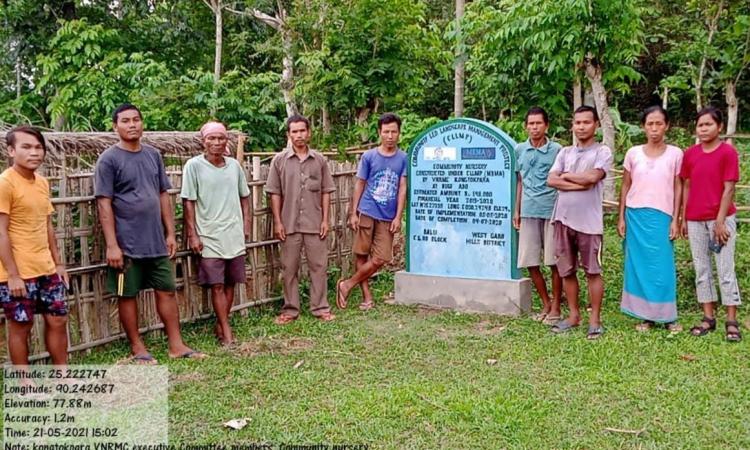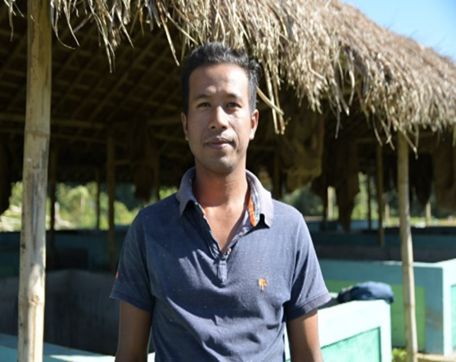
Meghalaya, a small hilly state located in the North Eastern Region of India has an area of 22,429 sq. km., which is 0.68% of the country’s geographical area. The state is divided into three regions: Garo Hills, Khasi Hills and Jaintia Hills. As per the 2011 census, Meghalaya has a population of 2.96 million accounting for 0.24% of the country’s population.
81% of Meghalaya’s population is dependent on agriculture and allied activities as the primary source of livelihoods. Youth in the age group of 15-24 years comprises 20.60% of the state’s total population; most of them reside in rural areas.
The state has one of the highest forest cover in the country with over 76% of the total geographical area (India State of Forest Report, 2019). Of the total forest cover in the state, only 1145.19 sq. km of forest areas (5.10% of the geographical area) comes directly under the control of the State Forest Department. (Meghalaya Forest Department website, 2021)
The management of the remaining forest areas lies with the communities, clan, private people and District Councils in different capacities, as Meghalaya is one of the states with Sixth Scheduled Areas as prescribed in the Indian Constitution.
Engaging youth in managing natural resources
Unemployment is one of the biggest challenges faced in Meghalaya, as in many other parts of the country, mainly because of the burgeoning population, the high birth rate (higher than the national average) and limited opportunities in the formal employment sector.
In Meghalaya, managing natural resources like soil, forest, fauna and water is problematic without communities leading the efforts. It has been observed that indigenous people historically have immense knowledge about their environment and natural resources, and this knowledge is passed down orally through generations. However, due to lack of documentation and change in lifestyle with the advent of technology, the knowledge is dwindling and diluting with time. There is a threat to this knowledge becoming extinct.
The large youth population in the state and the importance of employing them productively in the local ecosystem is the need of the hour. Hence, the state has been exploring the possibilities of improving the employment opportunities for them in the state directly or indirectly in the natural resource management sector, especially in the rural areas.
This includes the set of people who have formal education in related fields but are yet to be gainfully employed or engaged to sustainably serve their communities. It also opens up a huge potential for people of the state including youth with lesser formal education or vocational training but having an affinity to conserve and manage their environment and natural resources.
In this context, the Meghalaya Community Led Landscape Management Project (MCLLMP), jointly funded by the Government of Meghalaya and World Bank, is in the process of investing and training the youth (both male and female), in all parts of Meghalaya.
There was an initiative way back in 2015-2016 when identification and capacity building of around 3,000 young Green Volunteers had taken place, but their services were not fully realised and utilised until recently, as there were some gaps in the process.
Based on learnings from this initiative, the MCLLMP has endeavoured to identify and train over 20,000 Village Community Facilitators (VCFs) on natural resource management, to guide, support and assist the communities in formulating plans for their respective villages, so that they can manage their natural resources locally and sustainably.
As of date, there are 1200 VCFs functioning in 400 villages across Meghalaya. Furthermore, as envisioned in the State Water Policy, 2019, these VCFs will also assist their village to create Village Water Security Plans to ensure safe and clean drinking water which is in consonance with the Sustainable Development Goal 6: Clean Water and Sanitation.
This effort is not a single agency driven but a concerted effort of multiple departments/agencies from the state of Meghalaya and non-profit organizations, private sector partners from outside the state who came together to make this initiative a reality.
Some of these departments/agencies are Soil and Water Conservation Department (Training Partner); State Rural Employment Society - under MGNREGS (Implementation Partner); Meghalaya Institute of Natural Resources; Arghyam (Capacity Building Partner); Socion (Technology Partner); and Springshed Initiative Partners (Training Partner).
Technology has been the cornerstone of this entire program and is being leveraged to assist in the training and also in the implementation of the plans developed by the communities – the Water Security Plans and the Community Natural Resource Management Plan.
As per the lessons learnt from the Green Volunteers initiative, these VCFs will be empanelled in the Centre of Excellence (CoE), whereby their services can be continued even after the programmes/projects are over. Other departments, that want to tap into the skillset of VCFs have already started processes to engage them in their departmental programs. Any philanthropic initiative or entrepreneurial projects in the future can also leverage this skilled cadre to their project’s advantage.
Another initiative that the Government of Meghalaya is exploring is that the majority of the VCFs would be accredited by the National Skills Development Corporation. There are multiple benefits of having accredited VCFs empanelled in the Centre of Excellence.
It ensures quality service delivery to the clients who recruit them for projects in future. It also makes certain that the VCFs continue to have gainful employment by showcasing their knowledge and skills. This cadre of certified and recognized community leaders will shape the future of natural resource management as well as livelihoods based on it in the villages of Meghalaya.
Rangshanbor Kharbihkhiew, a VCF in the program says, “Initially I was not truly aware what being a VCF meant or what the role entails. I accepted the role as I was eager to help and contribute to the development of my village. I have witnessed many people in the village struggle with the scarcity of water. So, after hearing about CLLMP, I wanted to be a part of the project and do my bit to help. After joining the program as a VCF, I was trained by CLLMP officials in the use of GIS and Geospatial Technology and in the monitoring of the ongoing projects using photographs.”
“I have noticed that the CLLMP is faster and is more agile compared to other projects. The CLLMP personnel are always very eager to come to the village to help and are ever ready to communicate and clarify any problem we, as a village, might have. They try to ensure the smooth functioning of the projects to the best of their abilities. They are mostly clear and concise with their information and instructions. Although I did not understand at first how important this role is, I am now very grateful for this chance and opportunity to be a VCF, to be a part of this project. To do my part to help the village and the community. To be one of the leaders in our effort to preserve the environment and combat water scarcity in our village,” says Kharbihkhiew.

Mr. Rangshanbor Kharbihkhiew, VCF - Environment Management & GIS (Image: Meghalaya Basin Management Agency)
Meghalaya leads by example
This experience from Meghalaya demonstrates a model of utilizing trained human resources for the conservation and protection of the state’s natural resources while generating local livelihoods for a few and sustaining natural resources-based livelihoods for the rest of the community. This is an example of the government collaborating with civil society and private sector actors to tackle a complex problem of unemployment and degrading natural resources while leveraging technology to fill gaps.
James T. Kharkongor is Deputy Project Director at Meghalaya Basin Management Agency. Views expressed are personal.
/articles/managing-natural-resources-scale-meghalaya